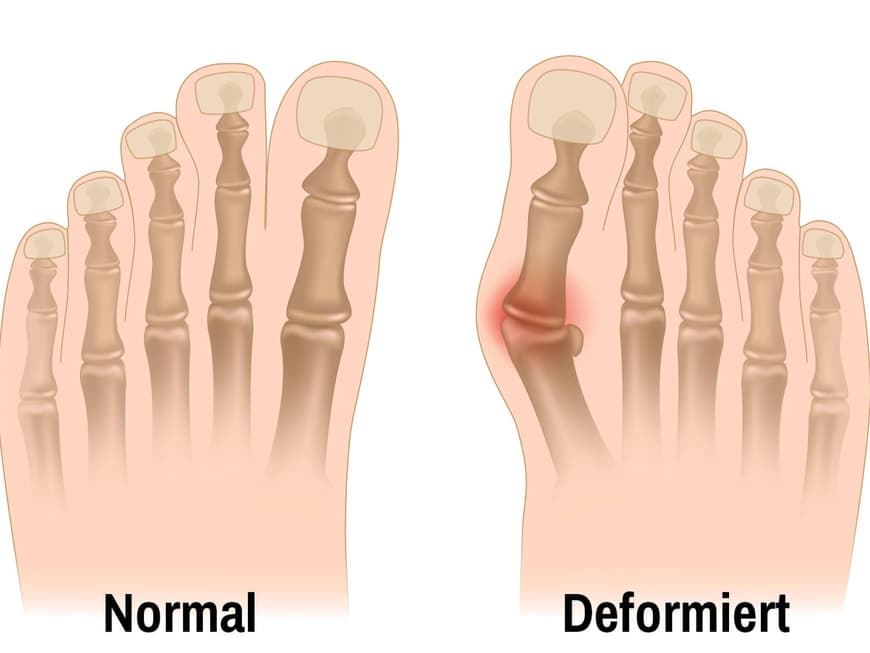How does a bunion develop in the first place?
"With hallux valgus, the first metatarsal bone is pushed outwards, resulting in a visibly protruding bunion. The pressure of shoes on the displaced joint leads to irritation and swelling - painful bursitis can also develop."
What is the cause of hallux valgus and why are women particularly affected?
"Because of their shoes, which often have high heels and are pointed at the front. Women also have weaker connective and supporting tissue than men, which can cause the bones to shift. Hormonal changes, such as during pregnancy, can make the connective tissue even more flexible. Predisposition also plays a major role; sometimes entire families are affected, from grandma to granddaughter."
How is the disease diagnosed?
"In addition to a physical examination, an X-ray shows how far the painful deformity has progressed."
Does a bunion get worse over time?
"There is a risk that the toes will become even more deformed. In extreme cases, the big toe can almost lie across the other toes. A hallux valgus can also lead to osteoarthritis over time, as the joint wears out more quickly due to the deformity."
Does a bunion need to be operated on immediately?
"No, it doesn't always have to be operated on straight away. In mild cases, a lot can often be achieved by relieving pressure on the toes. I recommend wearing wide, soft shoes. Insoles and special physiotherapy can also often significantly improve the symptoms."
And when is surgery better?
"Hallux valgus surgery is indicated if conservative measures are unsuccessful. And especially if pain is added. The patient then decides for themselves depending on their level of suffering. In order to correct the hallux, the bone must be cut and the crooked big toe brought into the correct position. To ensure that the bones grow together properly, they must be screwed, plated or wired together. There are several procedures, depending on the severity and location of the deformity."
Can minimally invasive surgery be performed?
"Yes, screws and - if necessary - plates can now be inserted into the foot via tiny incisions. The big advantage is that there are only small incisions and scars. But even with conventional surgical methods, the scars are small and barely visible. The duration of aftercare and the extent of discomfort are not much different with minimally invasive techniques, on the contrary: it is not uncommon for the swelling to be even more pronounced after the operation."
What is the aftercare like?
"In most cases, hallux patients can put full weight on their foot again immediately after the operation. However, they should definitely wear a special bandage shoe for six weeks. During this time, lymphatic drainage is often useful to treat the swelling. Physiotherapy is also recommended. As a rule, the patient will be rid of their bunion for good after hallux surgery."
Fact check
These surgeries are available:
➜ Chevron osteotomy
This is used for mild forms of hallux valgus (deformity < 15 degrees). A V-shaped bone separation is performed at the level of the first metatarsal head. The metatarsal head is moved outwards and fixed in place with a titanium screw.
Basic osteotomy
A base osteotomy is an option for pronounced deformities. A wedge-shaped piece of bone is removed from the base of the metatarsal bone and the malalignment is corrected by this angle. The new position is fixed with a small metal plate and screws so that the bone can heal in the corrected position.
Lapidus arthrodesis
This operation is mainly performed in cases of abnormal mobility in the joint and instability of the metatarsal bone: the first metatarsal bone and the first tarsal bone are connected in the corrected position with screws and a titanium plate, thus stiffening them.
➜ Surgery according to Akin
Akin surgery is suitable for bony misalignments in the big toe. A small wedge is removed from the bone in the metatarsophalangeal phalanx. The big toe is then pushed into the desired position. This position is fixed with a small screw, plate or titanium clip.
Strengthening the foot: how to prevent hallux valgus
➜ Walk barefoot
This is doping for the feet: all ligaments, tendons and muscles are challenged and strengthened. Walking barefoot on soft sand or grass is good for you. It is better not to walk on hard parquet or tiles - the surface does not cushion and the foot is put under strain.
➜ Flat shoes
Completely flat shoes are not good either, as the foot often has no support and wobbles in the shoe. Heels of three to five centimetres are best.
➜ Spiral dynamics
Special exercises strengthen the foot. For example, place the outer edges of your feet together and move the soles of your feet as if you were clapping your hands.


